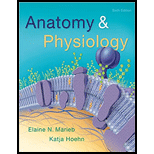
Concept explainers
All of the following are considered innate body defenses except(a) complement, (b) phagocytosis, (c) antibodies, (d) lysozyme, (e) inflammation.
Introduction:
The immune system is majorly divided into two parts: Innate immune system and Adaptive immune system. The innate immune system is considered as an older evolutionary defense strategy, found in plants, fungi, insects and primitive multicellular organisms. The main strength of innate body defense is the ability to take action very fast. But this type of innate immune response is not specialized for specific pathogens, so it does not require a long start-up phase. This type of broad effect makes it capable to some extent from stoping germs entry and spread in the body.
Answer to Problem 1MC
Correct answer:
The mechanism of “innate body defense” includes all except antibodies.
Explanation of Solution
Explanation for the correct answer:
Innate body defense is the nonspecific immunological response that is generated by the body against the pathogens. It comprises the inflammation process, lysozyme action, phagocytosis process, and the complement activation reaction. In contrast, the antibodies generate a specific immune response. These are formed by the B cells in response to the encounter of pathogens. Hence option (c) is a correct option.
Explanation for the incorrect answers:
Option (a) states that the mechanism of “innate body defense” includes all except complement. This is a false statement as complement system is a part of innate immunity, which increases the ability of antibodies and phagocytic cells to destroy microbes and promotes inflammation. Hence option (a) is an incorrect option.
Option (b) states that the mechanism of “innate body defense” includes all except phagocytosis. This is a false statement as phagocytosis is a part of innate immunity, and helps in elimination of pathogens that might cause infection. Hence option (b) is an incorrect option.
Option (d) states that the mechanism of “innate body defense” includes all except lysozyme. This is a false statement as lysozyme action is a part of innate immunity that works by attacking the perptidoglycan component of certain bacterial cell wall. Hence option (d) is an incorrect option.
Option (e) states that the mechanism of “innate body defense” includes all except inflammation. This is a false statement as inflammation is a part of innate immunity, which includes the influx of blood plasma and immune cells to infected or injured area. Hence option (e) is an incorrect option.
Thus it is concluded that innate body defense comprises the inflammation process, lysozyme action, phagocytosis process, and the complement activation reaction. In contrast, the antibodies generate a specific immune response.
Want to see more full solutions like this?
Chapter 20 Solutions
ANATOMY&PHYSIOLOGY W/CD+ATLAS+ACCESSCO
- Acquired or adaptive immunity can be divided in to Natural Active, Natural Passive, Artificial Active, and Artificial Passive Immunity. Which types will lead to long lasting immune protection? Which will provide short term protection?arrow_forwardDistinguish susceptibility from resistance, and innate from acquired immunity. Why are these traditionally recognized types of immunity now more difficult to distinguish?arrow_forwardWhen is antigen processing an essential prerequisite for an immune response?arrow_forward
- What will happen to the human immune system when a microorganism invading the body lacks the inherent ability to activate complement or bind to phagocytes?arrow_forwardWhat are some examples of innate defense mechanisms that are chemical in nature? What is complement?arrow_forwardContrast active and passive immunity in terms of how each is acquired,how long it lasts, whether memory is triggered, how soon it becomeseffective, and what immune cells and substances are involved.arrow_forward
 Biology: The Dynamic Science (MindTap Course List)BiologyISBN:9781305389892Author:Peter J. Russell, Paul E. Hertz, Beverly McMillanPublisher:Cengage Learning
Biology: The Dynamic Science (MindTap Course List)BiologyISBN:9781305389892Author:Peter J. Russell, Paul E. Hertz, Beverly McMillanPublisher:Cengage Learning Human Biology (MindTap Course List)BiologyISBN:9781305112100Author:Cecie Starr, Beverly McMillanPublisher:Cengage Learning
Human Biology (MindTap Course List)BiologyISBN:9781305112100Author:Cecie Starr, Beverly McMillanPublisher:Cengage Learning


